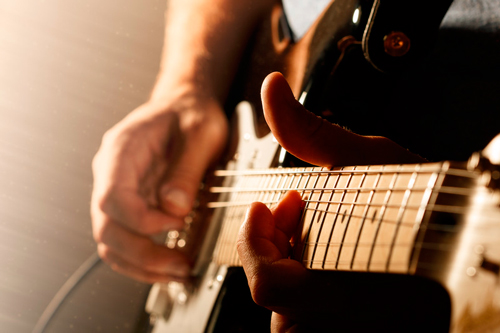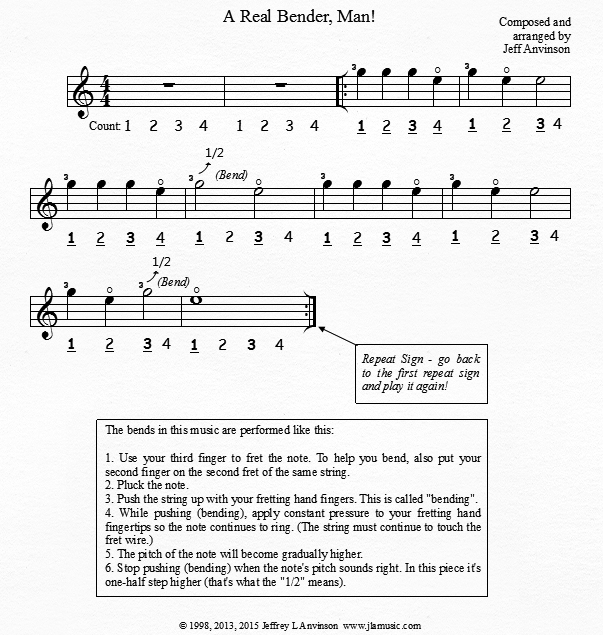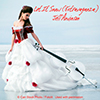Learning Guitar Notes: E and G - A Real Bender, Man!
created for Tony

If you know the notes E and G on the first string (open and third fret) you are ready to try this piece called "A Real Bender, Man!". I wrote it for a young guitar student many years ago to help him learn how to read staff notation. (You may want to review the pages on this website that teach the notes E (found here) and G (found here).) The title of the piece is a play on the word "bender" of course, because bending can be a bit intoxicating, but in a good way. (I am in no way recommending that you get intoxicated on alcohol while playing guitar, as I make clear in my web article about beer and guitars found here.) ;-)
This piece uses a special guitar technique called string bending. Bending a string involves pushing the string literally up or pulling it down while applying pressure to a fretted note. In case you're wondering, pushing up or pulling down produce the identical effect. (By the way, you can't push the top string up, or pull the bottom string down, because they will be forced off the side of the fingerboard, producing a strange sound.) Check out the picture above to see a guitar player performing this technique. Bending stretches the string, which makes it vibrate faster, causing the pitch to raise. It is one of the coolest things you can do on a guitar. Often, to help make bending a string easier, a second, third (or even fourth) finger is placed on the string on a fret (or frets) to the left of the note that is being bent. Using two, three, or even four fingers to bend a single string is sometimes easier than trying to bend it with one finger - though seasoned players can bend a string using only one finger.
The trick to bending is to squeeze between the fretting finger and thumb while simultaneously pushing up or pulling down. (This is not the easiest thing to learn so don't get discouraged!) This keeps the string in contact with the fret wire so that it continues to vibrate and produce a pitch. (You can also pull back with the fretting hand and arm while simultaneously pulling back with the strumming arm, almost like you're trying to break your guitar in half. (Don't worry - I've never seen anyone actually break their guitar this way!) This technique can reduce the amount of squeezing required by your fretting finger and thumb.)
To make this piece easier to learn and ultimately more fun to play, two audio accompaniment tracks are located directly below the music - one at a slow tempo and a second one at a faster tempo. Try the slow one first till you've mastered the piece, then play the fast one and rock out! Remember to count two measures of rest at the beginning. If your computer audio system allows you to play the tracks in stereo, the right channel is the guitar and the left channel is the accompaniment. Adjust the balance to the extreme right or left if you want to hear one or the other, in the center for both.
Have fun!
Jeff Anvinson, owner/operator of JLA Music

Accompaniment Track - Slow Version
Accompaniment Track - Fast Version
(Click here to get a PDF version of this music. Please don't distribute this PDF by photocopying or posting it on the internet. You may print out one copy for your own use. If you know someone who wants a copy, simply refer them to this website. Please help me protect my intellectual property by respecting my rights.)
Website and most graphics are created inhouse by Jeff Anvinson, Owner/Operator of JLA Music
Some graphics are purchased from Can Stock Photo, used by permission, and are Copyright
© Can Stock Photo
JLA Music takes care not to infringe on anyone's rights. Please contact us at jla@jlamusic.com if you have questions.
Copyright 2025 © Jeff Anvinson, JLA Music


